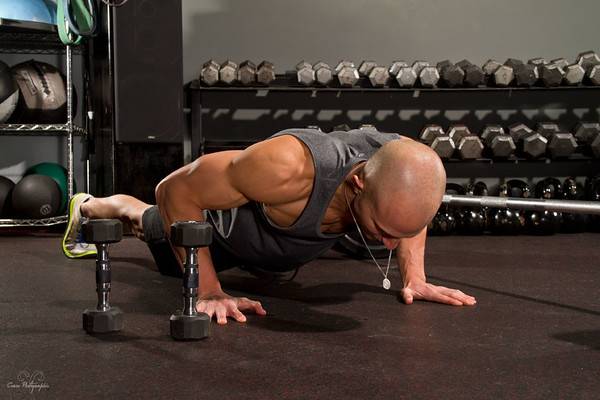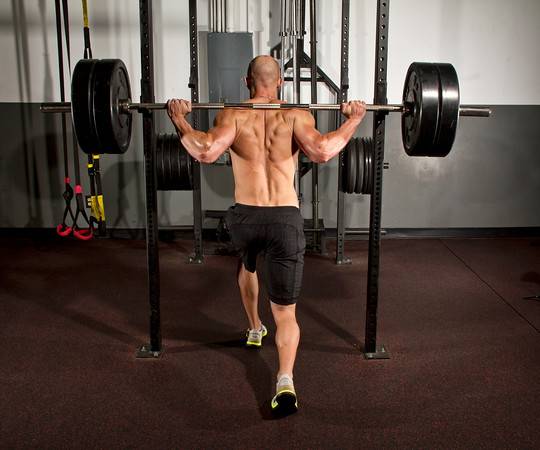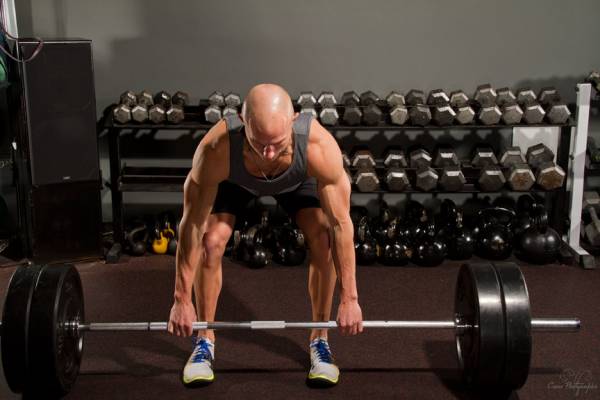What is pain-free hypertrophy training? It’s exactly what it sounds like. By using advanced training methods, you can achieve both the addition of lean muscle and the reduction of body fat without breaking down your body and ending up hurt in the process. Sounds good, right?
Here are a few of my top training methods I use to accomplish these goals in a pain-free manner with my own clientele. And just as a head’s up – this is not your average bodybuilder program.
Pain-free hypertrophy training will help you build lean muscle without breaking your body.
1. Specialized Pre-Training Warm Ups
Cookie cutter warm ups are one of my biggest pet peeves in programming. The warm up, more than any other aspect of a balanced program, needs to be custom fit to an individual’s level, recovery ability, and, most importantly, movement dysfunction.
Sure, for some people strategically targeting a few areas with self-myofascial release techniques before jumping into a training session can enhance a workout, but by no means is this a requisite for every person’s program. The same can be said for general warm ups to increase heart rate and blood flow.
My general rule of thumb for warm-up routines is to follow a basic, but strategic progression through three phases:
- General Warm Up
- Dynamic Warm Up
- Neural Activation Techniques
The goal is to minimize the time spent in each phase and continuously reassess if the time spent results in any noticeable benefits to either your function or performance.
“The warm up, more than any other aspect of a balanced program, needs to be custom fit to an individual’s level, recovery ability, and, most importantly, movement dysfunction.”
General warm ups can be as easy as jumping on any cardio machine. If the thought of jogging on a hamster wheel turns you off as much as I think it will, no worries. Feel free to go on a brisk walk, jump on the Airdyne, or even get on the elliptical. Start out with a five-minute duration. Your goal is to decrease this over time.
Depending on the focus of your training day, specific dynamic warm ups can be implemented to increase local tissue temperature, lubricate active joints, and work on movement and mobility. Here’s an example:
- Jump Squats– 10
- Seal Jacks – 15
- Prisoner Squat – 10
- Push-Up – 6 (two-second hold at bottom position)
- Alternating Forward Lunges – 6 (per side)
- Stick Ups – 10
- Band Pull Aparts – 10
- Kneeling Psoas Stretch – 30 seconds (per side)
Last come the neural activation warm-up techniques that should be matched strategically to your training day focus. These are advanced techniques I only use with athletes who have great movement pattern foundations and who also have mastered all the mobility and stability requisites in their programs
My favorite activation techniques for lower body training days are jumps. For push heavy days, I have seen amazing results by implementing accommodating resistance rotator cuff work and explosive bodyweight pressing movements like the push up. Go-to movements for pull days include direct glute work like bridge variations, along with functional lateral hip stability movements.

Explosive bodyweight pressing movements like the push up are some of my favorite warm ups.
2. Primer Strength Movements
Early on in my career, I was taught to program the most important compound movement of the day first in a program. It made sense. First things first, right?
Though many protocols from my early days in high-performance strength and conditioning helped shape my current training methodology – this tip to go heavy right away isn’t one of them.
“The first movement or two in every training program will have a specific intent and purpose that feeds the rest of the training day and gets our bodies and minds ready to succeed.”
The problem with this approach for most people is that the body isn’t ready for maximal effort early in a session. The specific tissues you are targeting need more time and reps to be fully primed for the epic performances that create results, not injuries.
Does this mean we aren’t going to lift heavy? No, that couldn’t be further from the truth. We are going to get under some serious weight, but only when our bodies are ready. How do we get there? Through primer strength movements.
The first movement or two in every training program will have a specific intent and purpose that feeds the rest of the training day and gets our bodies and minds ready to succeed.
The first movement needs to have a few distinct properties to work as a primer:
- The movement must be programmed with higher rep ranges than your average strength set/rep scheme.
- The intent of the movement is to tap into the mind-muscle connection and groove the pattern you are executing with constant tension and accentuated ranges of motion. This drives blood flow to the tissues, lubricates joints, and pumps the region.
These primer movements should always be easy on the joints, as many of them will be programmed with an extraordinary amount of volume. But after your first taste of primer sets, if you are like me, your training will never be the same.
3. Heavy Tempo-Based Strength Work
How does the old saying go? If you lift long enough with the right intensities and heavy-ass loads, you will eventually be injured. There is some truth to that based on statistics – but not if you train like I suggest. With this approach, you’ll be part of the chosen few who are going to lift heavy and reap the benefits of lean muscle growth and fat loss without the derailing injuries.
“The use of strategic variations of the big movements allows us to adapt to new training stimuli while also being challenged by changes in joint angles, core stability and foot and hand positions.”
After we are primed and ready to go, I like to program the big movements of the day. As with many highly successful programs that have stood the test of time, our primary strength work is going to be based around the bench press, squat, and deadlift.
Does that mean that every session is going to look the same? Hell no! The use of strategic variations of the big movements allows us to adapt to new training stimuli while also being challenged by changes in joint angles, core stability and foot and hand positions.
Along with changing up the big movement themselves through slight variations in setups, my methodology also employs strategic tempo-based strength work. At certain points in a program, we bring out all the tempo changes, intensity techniques, and challenge sets that produce results, not injuries.
There is a difference between mindlessly going hard in the gym and having a calculated approach to workout brutality. Trust me – choose the second.

Strategic variations of the big movements allow us to adapt to new training stimuli.
4. Loaded Stretches and Accentuated Ranges
As a strength coach who also sports a doctorate in physical therapy, I often get asked the age-old question of whether stretching is a requisite aspect of a fitness program. My answer is always yes – but the next thing I say catches people off guard.
Should everyone stretch? I think so. Should everyone practice long-duration static stretching? No way. There are times that static stretching for longer than 30-45 seconds can be useful. But I haven’t been exposed to those times when it comes to aesthetics and hypertrophy training. What do I believe works?
“Should everyone stretch? I think so. Should everyone practice long-duration static stretching? No way.”
I am a believer in using full ranges of motion for the majority of movements, along with programming loaded stretches to nail down functional mobility that translates into performance and bulletproofed bodies. One of my favorite regions to target with this method is the chest and lats. After just a few seconds under a loaded stretch, you can kiss the need for static stretching goodbye.
The truth is posture is one of our most limiting factors in Western society, so prioritizing programming that not only enhances good posture, but retrains your tissues to release tightness under heavy loads is the quickest way to fixing dysfunctional or painful positioning.
5. Primary vs. Secondary Splits
Not every training day needs to be balls to the wall. In my opinion, each muscle group or functional pattern should be hammered once a week. When you are training at the right intensities and pushing your limits on every single set, once a week may even seem like a bit much.
Lifting is not an activity with only one gear. We need to train strategically based on our overall recovery and the regeneration of tissues. When both of these aspects are on point, the use of secondary training days becomes of huge benefit.
“Secondary days are programmed with higher set and rep schemes that are largely pump or conditioning focused.”
In many of my programs, we hit it hard and heavy early in the week, trying to squeeze every rep out of our bodies until we no longer have any gas in the tank. But using techniques like primer sets, tempo-based strength work, and loaded stretching, you can get pretty fried quickly. So along with all that fun comes the need to recover properly.
The addition of a dialed-in nutritional program along with taking care of simple things like hydration and sleep can go a long way to get your body back to baseline. And when recovery is proven out on a week-by-week basis, there may be a window where we program additional split-focused days to increase volume and give our bodies another chance to grow and torch fat. But these additional days will not look the same as your primary training days – far from it.
Secondary days are programmed with higher set and rep schemes that are largely pump or conditioning focused. Also, they employ variations of the big movements that are more joint friendly and have less need for heavy core and pelvic bracing. This keeps the emphasis on the muscles as opposed to the joints and connective tissues that can be notoriously gnarly with high-frequency style training.

We need to train strategically based on our overall recovery and the regeneration of tissues.
Consistent Strategy Is Key
As I mentioned, this approach is not your typical approach. But you also won’t experience your typical results. Your performance will continue to progress, your body will continue to lean out, and you won’t experience the injuries that leave you sitting on the bench. Consistency is key – and strategic training is the key to consistency.
More Like This:






